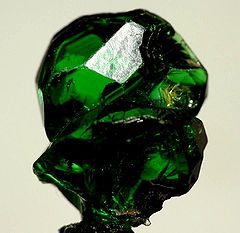Tsavorite
| Tsavorite | |
|---|---|

Gem-quality Tsavorite from Tanzania, 0.9 x 0.7 x 0.4 cm.
|
|
| General | |
| Category | Mineral |
|
Formula (repeating unit) |
Ca3Al2Si3O12 |
| Crystal system | cubic |
| Identification | |
| Color | Light to deep green |
| Mohs scale hardness | 7 – 7.5 |
| Specific gravity | 3.60–3.68 |
| Optical properties | Single refractive |
| Refractive index | 1.740 |
| Dispersion | 0.028 |
Tsavorite or tsavolite is a variety of the garnet group species grossular, a calcium-aluminium garnet with the formula Ca3Al2Si3O12. Trace amounts of vanadium or chromium provide the green color.
In 1967, British gem prospector and geologist Campbell R. Bridges discovered a deposit of green grossular in the mountains of north-east Tanzania in a place called Lemshuko, 15 km (9.3 mi) away from Komolo, the first village. The specimens he found were of very intense color and of high transparency. The find interested the gem trade, and attempts were made to export the stones, but the Tanzanian government did not provide permits.
Believing that the deposit was a part of a larger geological structure extending possibly into Kenya, Bridges began prospecting in that nation. He was successful a second time in 1971, when he found the mineral variety there, and was granted a permit to mine the deposit. The gemstone was known only to mineral specialists until 1974, when Tiffany and Co launched a marketing campaign which brought broader recognition of the stone.
Bridges was murdered in 2009 when a mob attacked him and his son on their property in Tsavo East National Park. It is believed that the attack was connected to a three-year dispute over access and control of Bridges' gemstone mines.
The name tsavorite was proposed by Tiffany and Co president Sir Henry Platt in honor of Tsavo East National Park in Kenya. Apart from the source locality in Tanzania it is also found in Toliara (Tuléar) Province, Madagascar. Small deposits of gem grade material have been found in Pakistan and Queen Maud Land, Antarctica. No other occurrences of gem material have been discovered.
...
Wikipedia
